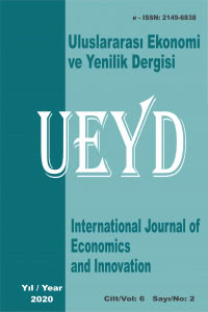Türkiye Ekonomisi Cari Açığı Sürdürülebilir Mi? Birim Kök Testleriyle Bir İnceleme
Bu çalışmada, Türkiye ekonomisi cari açığının sürdürülebilirliği 1992:I-2017:IV dönemine ait çeyreklik cari denge Gayrisafi Yurtiçi Hasıla (GDP) oranı ve 1992:01-2017:12 dönemine ait aylık reel cari denge ve kişi başına reel cari denge olmak üzere üç ayrı seriye uygulanan kırılmalı ve kırılmasız birim-kök testleri ile analiz edilmektedir. Kırılmasız birim-kök test sonuçları genel olarak serilerin durağan olmadığını, tersine kırılmalı birim-kök test sonuçları ise genel olarak serilerin durağan ve dolayısıyla cari açığın sürdürülebilir olduğunu göstermektedir. Her ne kadar Türkiye ekonomisi cari açığı kırılmaların dikkate alınması durumunda durağan bulunsa da, durağan bulunan “(Cari Açık)/GDP” serisinin ortalaması çok yüksek ve literatürde kriz eşiği olarak görülen oranlara oldukça yakındır. Bu nedenle cari açık önemli bir sorun olarak ele alınmalı ve göz ardı edilmemelidir.
Anahtar Kelimeler:
Cari Açık, Sürdürülebilirlik, Türkiye Ekonomisi, Birim Kök Testleri
___
- Bhargava, A. (1986). On the theory of testing for unit roots in observed time series. Review of Economic Studies, 53(3), 369-384.
- Campbell, J. Y. ve Shiller, R. J. (1987). Cointegration and tests of present value models. Journal of Political Economy, 95(5), 1062-1088.
- Cashin, P. ve McDermott, C. J. (1998). Are Australia's current account deficits excessive? Economic Record, 74(227), 346-361.
- Chen, S. W. (2011). Current account deficits and sustainability: Evidence from the OECD countries. Economic Modelling, 28(4), 1455-1464.
- Dickey, D. A. ve Fuller, W. A. (1979). Distribution of the estimators for autoregressive time series with a unit root. Journal of the American Statistical Association, 74(366), 427-431.
- Elliott, G., Rothenberg, T. J. ve Stock, J. H. (1996). Efficient tests for an autoregressive unit root. Econometrica, 64(4), 813-836.
- Fountas, S. ve Wu, J. L. (1999). Are the U.S. current account deficits really sustainable? International Economic Journal, 13(3), 51-58.
- Ghosh, A. R. (1995). International capital mobility amongst the major industrialised countries: Too little or too much? The Economic Journal, 105(428), 107-128.
- Ghosh, A. R. ve Ostry, J. D. (1995). The current account in developing countries: A perspective from the consumption-smoothing approach. The World Bank Economic Review, 9(2), 305-333.
- Hakkio, C. S. ve Rush, M. (1991). Is the budget deficit “too large?” Economic Inquiry, 29(3), 429-445.
- Husted, S. (1992). The emerging US current account deficit in the 1980s: A cointegration analysis. The Review of Economics and Statistics, 74(1), 159-166.
- Kwiatkowski, D., Phillips, P. C., Schmidt, P. ve Shin, Y. (1992). Testing the null hypothesis of stationarity against the alternative of a unit root: How sure are we that economic time series have a unit root? Journal of Econometrics, 54(1-3), 159-178.
- Lee, J. ve Strazicich, M.C. (2003). Minimum Lagrange multiplier unit root test with two structural breaks. Review of Economics and Statistics, 85(4), 1082-1089.
- Lee, J. ve Strazicich, M. C. (2004). Minimum LM unit root test with one structural break. Manuscript, Department of Economics, Appalachian State University, 1-16.
- Liu, P. C. ve Tanner, E. (1996). International intertemporal solvency in industrialized countries: Evidence and implications. Southern Economic Journal, 62(3), 739-749.
- MacKinnon, J.G. (1996). Numerical distribution functions for unit root and cointegration tests. Journal of Applied Econometrics, 11(6), 601-618.
- Matsubayashi, Y. (2005). Are US current account deficits unsustainable? Testing for the private and government intertemporal budget constraints. Japan and the World Economy, 17(2), 223-237.
- Milesi-Ferretti, G. M. ve Razin, A. (1996). Sustainability of persistent current account deficits. National Bureau of Economic Research (NBER) Working Paper No. 5467, 1-31.
- Newey, W. K. ve West, K. D. (1994). Automatic lag length selection in covariance matrix estimation. Review of Economic Studies, 61(4), 631-653.
- Ng, S. ve Perron, P. (1995). Unit root tests in ARMA models with data-dependent methods for the selection of the truncation lag. Journal of the American Statistical Association, 90(429), 268-281.
- Ng, S. ve Perron, P. (2001). Lag length selection and the construction of unit root tests with good size and power. Econometrica, 69(6), 1519-1554.
- Phillips, P. C. B. (1987). Time series regression with a unit root. Econometrica, 55(2), 277-301.
- Phillips, P. C. B. ve Perron, P. (1988). Testing for a unit root in time series regression. Biometrika, 75(2), 335-346.
- Sivri, U. ve Seven, B. (2017). Ortalama tüketim eğilimi durağan mıdır? Türkiye ekonomisi için bir zaman serisi analizi. Anadolu İktisat ve İşletme Dergisi, 1(1), 50-65.
- Trehan, B. ve Walsh, C. (1991). Testing intertemporal budget constraints: Theory and applications to U.S. federal budget and current account deficits. Journal of Money, Credit and Banking, 23(2), 206-223.
- TÜİK (2018a). Konularına göre istatistikler, Nüfus ve demografi, Genel nüfus sayımları. http://www.tuik.gov.tr/PreTablo.do?alt_id=1059 (Erişim: 24.02.2018).
- TÜİK (2018b). Konularına göre istatistikler, Nüfus ve demografi, Adrese dayalı nüfus kayıt sistemi. http://www.tuik.gov.tr/PreTablo.do?alt_id=1059 (Erişim: 24.02.2018).
- Wickens, M. R. ve Uctum, M. (1993). The sustainability of current account deficits: A test of the US intertemporal budget constraint. Journal of Economic Dynamics and Control, 17(3), 423-441.
- Wu, J. L. (2000). Mean reversion of the current account: Evidence from the panel data unit-root test. Economics Letters, 66(2), 215-222.
- Wu, J. L., Chen, S. L. ve Lee, H. Y. (2001). Are current account deficits sustainable? Evidence from panel cointegration. Economics Letters, 72(2), 219-224
- ISSN: 2149-6838
- Yayın Aralığı: Yılda 2 Sayı
- Başlangıç: 2015
- Yayıncı: Seyfettin Artan
Sayıdaki Diğer Makaleler
Sosyal Zekânın Akademik Performans Üzerindeki Etkisinde Kültürel Zekânın Düzenleyici Rolü
Özlem AKAY, Cahit ÇELİK, Gülsen KIRAL
Örgütsel Sessizlik ve Boyutları Üzerine Nitel Bir Araştırma
Orta Gelirli Ülkelerde İnovasyon Performansının Etkinliğindeki Farklılıklar: Ampirik Bir Yaklaşım
Türkiye Hisse Senedi Piyasasında Spekülatif Balon Varlığının Ampirik İncelenmesi
Enerji Tüketimi ve Ekonomik Büyüme İlişkisi: Panel Eşanlı Model
PINAR HAYALOĞLU, SEYFETTİN ARTAN, SELİM KORAY DEMİREL
Entegre Raporlama ile ilgili Yapılan Çalışmalar: Literatür Taraması
